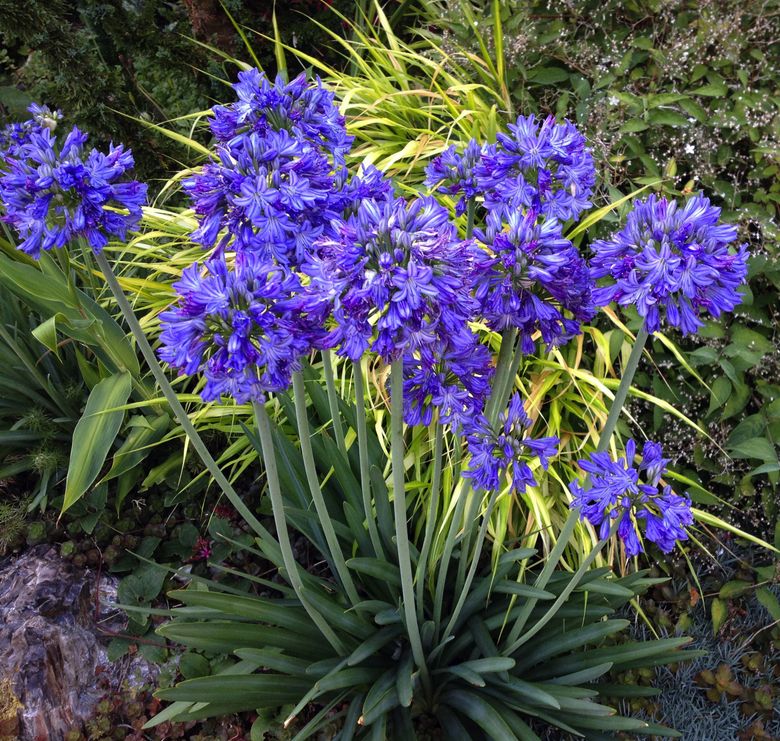Sensational Agapanthus: Enhancing Your Yard's Appeal
Sensational Agapanthus: Enhancing Your Yard's Appeal
Blog Article
Grasping the Art of Agapanthus Care: Essential Steps for Healthy And Balanced Development and Vivid Flowers
In the world of cultivation, the farming of agapanthus stands as a rewarding endeavor for those that look for to support these sophisticated blooming plants. With their striking blossoms and stylish foliage, agapanthus has caught the interest of garden enthusiasts worldwide. Nevertheless, accomplishing optimal development and lively blooms calls for a nuanced approach that includes different crucial actions. From selecting the ideal selection to understanding trimming methods, the trip towards growing growing agapanthus plants is multifaceted and holds the crucial to unlocking the complete possibility of these botanical treasures.

Selecting the Right Agapanthus Selection

When selecting the ideal Agapanthus range for your yard, take into consideration aspects such as environment viability, blossom color, and development practice. Agapanthus, generally called Lily of the Nile or African lily, is available in a selection of colors ranging from shades of purple and blue to white. Choose a flower shade that enhances your existing yard scheme to develop an unified landscape. Additionally, think about the climate in your region to guarantee the Agapanthus selection you choose can grow in your certain problems. Some ranges are more tolerant of cool temperatures, while others prefer warmer environments. Comprehending the development practice of various Agapanthus ranges is vital for correct positioning within your yard. Some ranges have a clumping growth behavior, suitable for boundaries or containers, while others have a more spreading nature, appropriate for ground cover or mass growings. By carefully reviewing these variables, you can pick the ideal Agapanthus selection to enhance the appeal of your yard.
Perfect Growing Problems
Thinking about the ideal environmental needs is crucial for successful Agapanthus cultivation. Agapanthus plants are sensitive to cold temperatures and need to be safeguarded from frost throughout winter season months.
To guarantee healthy and balanced growth and dynamic blossoms, plant Agapanthus bulbs at a deepness of about 2-4 inches and area them 8-12 inches apart. Including natural matter, such as compost, to the soil can boost drain and fertility, advertising durable origin development. Mulching around the base of the plants aids retain dampness and suppresses weed growth. Normal watering is critical, especially throughout the growing season, to maintain the dirt constantly wet yet not saturated.
Watering and Fertilizing Tips
Preserving correct moisture degrees and giving essential nutrients are vital elements in the care regimen for Agapanthus plants. When it comes to sprinkling Agapanthus, it is essential to strike an equilibrium. These plants choose regularly damp soil but are susceptible to root rot if overwatered.
Fertilizing Agapanthus is essential for advertising healthy and balanced growth and prolific flowers. Use a balanced plant food, such as a 10-10-10 formula, in the early springtime as new development emerges. By following these watering and feeding ideas, you can guarantee your Agapanthus plants flourish and produce vivid, lasting blossoms.
Pruning Methods for Agapanthus
Trimming Agapanthus plants at the suitable times and with appropriate methods is vital for maintaining their wellness and promoting optimum growth and flowering. The ideal time to trim Agapanthus is in late wintertime or very early springtime prior to brand-new development arises. Start by getting rid of any yellowing or dead leaves near the base of the plant. Cut them as close to the ground as feasible without damaging the emerging shoots.
For flowered stems, wait till the blossoms have actually withered and after that Get More Info trim them back to the base. This not only cleans the plant's look but likewise motivates the development of brand-new flower buds. Deadheading spent flowers can additionally reroute the plant's power right into producing even more blossoms instead of establishing seeds. However, if you desire to collect seeds for propagation, leave some flowers to dry and fully grown on the plant.
Remember to utilize clean, sharp devices to make exact cuts and minimize click for source the danger of presenting conditions. Agapanthus. Normal pruning will certainly help keep your Agapanthus looking healthy and balanced and cool while guaranteeing a bountiful display of stunning flowers
Dealing With Typical Bugs and Conditions
After ensuring correct pruning strategies for Agapanthus, it is vital to deal with usual insects and conditions that can influence the health and wellness and vitality of these plants. One usual bug that impacts Agapanthus is the Agapanthus gall midge.
One more common problem is fungal fallen leave spot, which offers as dark lesions on the fallen leaves. To stop fungal diseases, guarantee excellent air blood circulation around the plants, stay clear of overhanging watering, and get rid of any type of infected leaves immediately. Furthermore, Agapanthus plants can deal with origin rot if they are grown in badly draining soil. To stop this, plant Agapanthus in well-draining soil and stay clear of overwatering. By being attentive and taking prompt action against bugs and diseases, you can aid your Agapanthus plants flourish and create lively blossoms.
:strip_icc()/purple-agapanthus-4637b426-ba6babc24ea34dce9361ec746f6ebc63.jpg)
Verdict
Finally, grasping the art of agapanthus care entails picking the right range, offering excellent planting problems, appropriate watering and feeding, proper trimming strategies, and addressing usual pests and illness. By complying with these vital actions, you can ensure healthy and balanced development and lively blooms for your agapanthus plants. Keep in mind to regularly check and keep your plants to advertise their overall health and durability.
To make certain healthy development and dynamic blossoms, plant Agapanthus light bulbs at a depth of concerning 2-4 inches and room them 8-12 inches apart. By adhering to these watering and feeding ideas, you can find out more you can guarantee your Agapanthus plants flourish and create lively, lasting blossoms.
One usual insect that impacts Agapanthus is the Agapanthus gall midge. Furthermore, Agapanthus plants can endure from origin rot if they are grown in inadequately draining pipes dirt. By following these important steps, you can ensure healthy development and vibrant blossoms for your agapanthus plants.
Report this page